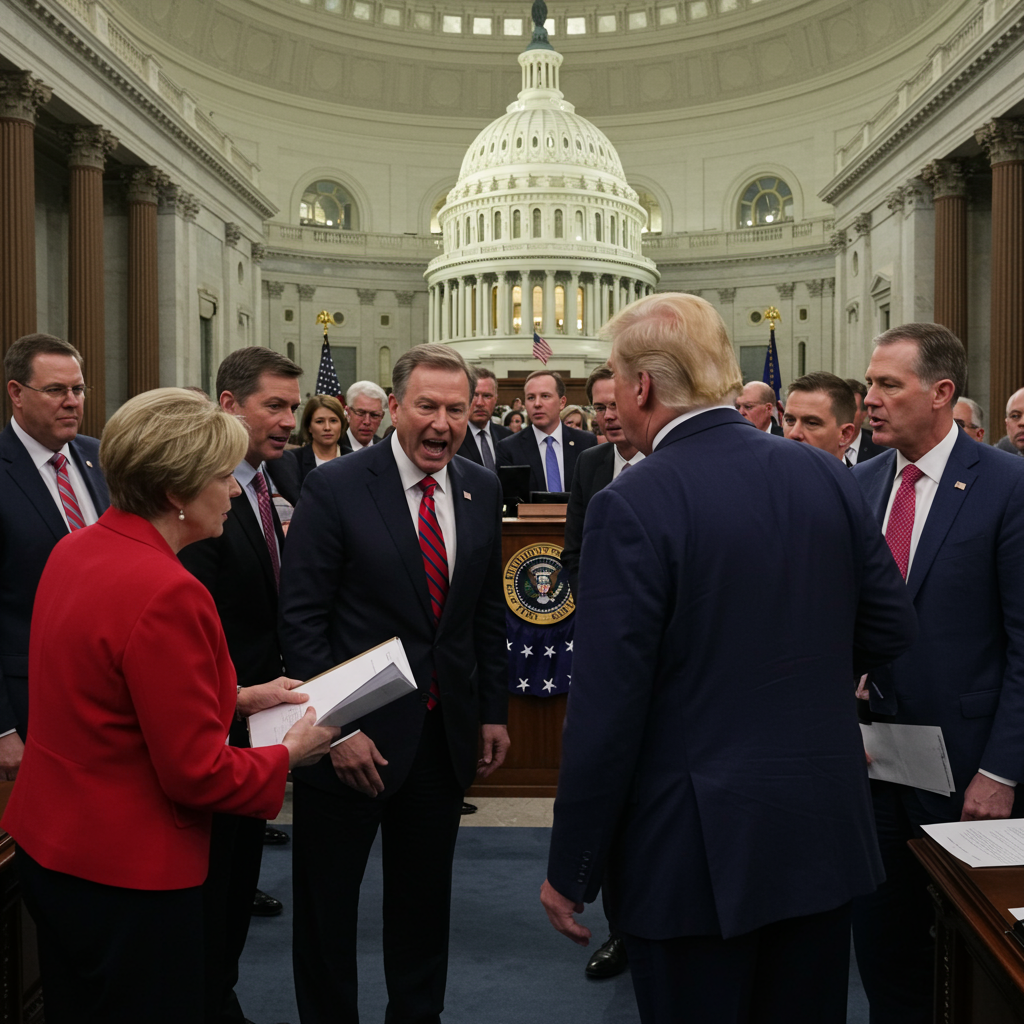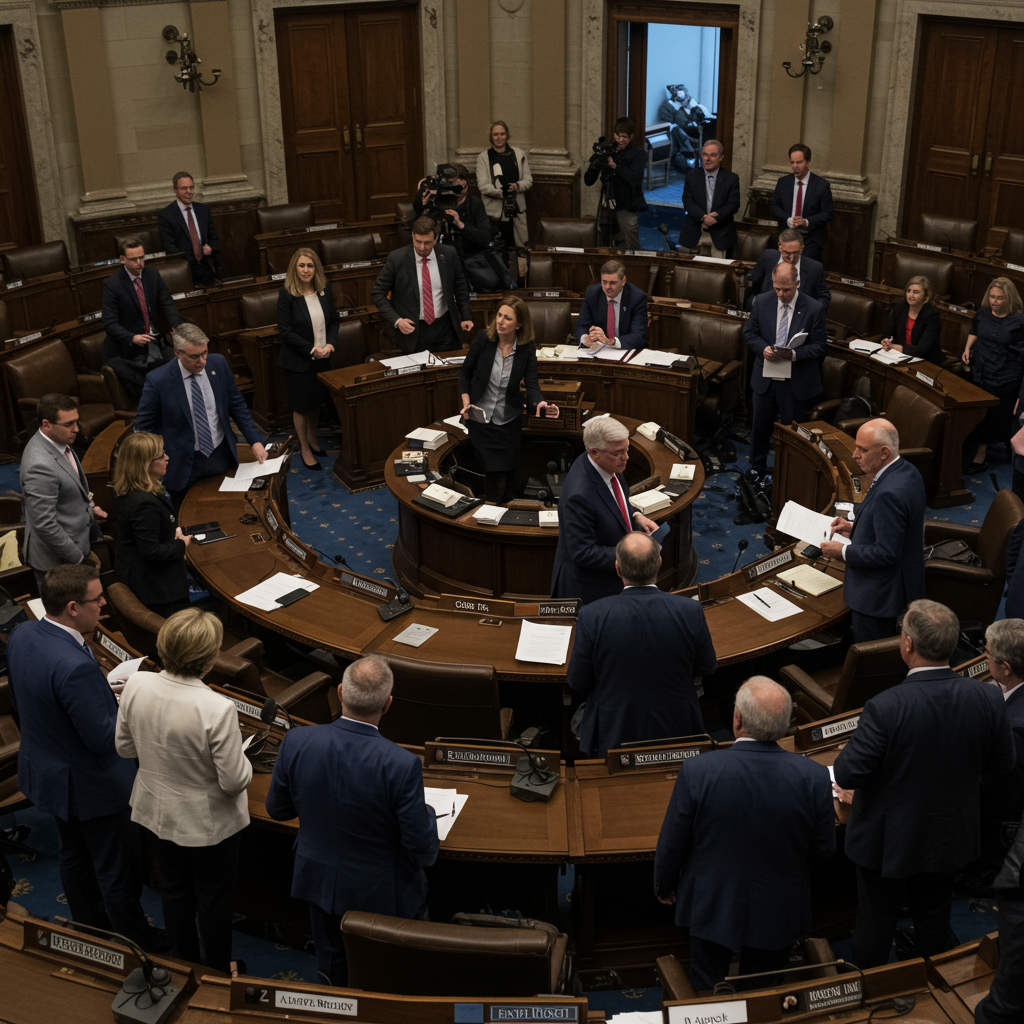Capitol Hill is buzzing as republicans push a massive legislative package, dubbed the “Trump megabill,” toward a rapid vote. Despite significant policy objections, procedural hurdles, and internal disagreements, the drive to pass this sweeping bill before a seemingly arbitrary deadline is intense. What’s the real force behind this urgent push? It’s less about the intricate policy details and more about fulfilling a political imperative set at the highest level.
This legislative effort is complex, aiming to reshape significant parts of the U.S. economy and government spending. The bill proposes extending many of the tax cuts enacted in 2017, potentially averting tax increases set to occur otherwise. Beyond tax policy, it allocates substantial funding, dedicating hundreds of billions towards national security, border enforcement measures, and boosting military budgets. However, the package also includes significant reductions to social safety net programs, prominently featuring deep cuts to Medicaid and potentially impacting food aid eligibility for millions.
The bill’s Far-Reaching Impacts
Analysts predict profound consequences if the “Trump megabill” becomes law. While proponents highlight tax relief and increased security spending, critics point to analyses suggesting the tax benefits heavily favor wealthy individuals and corporations. Concurrently, nonpartisan assessments project that cuts to programs like Medicaid could lead to millions of Americans losing their health insurance coverage.
The proposed changes extend beyond taxes and healthcare. The bill touches on areas like tax deductions (with internal GOP debate around lifting caps on State and Local Taxes, or SALT, deductions) and even smaller, yet controversial, provisions such as eliminating taxes on tips. The sheer scope of the legislation means its effects would be felt across various sectors of the economy and segments of the population, drawing sharp contrasts between potential beneficiaries and those facing reduced services or increased financial burdens. The bill’s broad unpopularity is a recurring theme, with public opposition often increasing as specific provisions become widely known, mirroring the public reaction to the 2017 tax changes.
Driving Force: An Arbitrary Political Deadline
Central to the current legislative scramble is a self-imposed deadline. President Trump has repeatedly expressed a desire to sign the “big, beautiful bill” by July 4th. This date holds no statutory significance for the bill’s passage; critical legislative timelines, such as addressing the debt ceiling, fall much later in the year. Yet, this arbitrary deadline has dictated the pace on Capitol Hill.
Despite brief moments of suggesting flexibility on the date, President Trump quickly reverted to demanding the House send the bill to his desk before July 4th. This presidential insistence exerts immense pressure on Republican leaders in Congress. They are working furiously to meet this deadline, even if it means bypassing more deliberate processes that could refine the bill, build broader consensus, or ensure procedural compliance. The urgency appears rooted in the political optics of delivering a major legislative achievement for the president by a symbolically significant date, rather than stemming from policy necessity or a traditional legislative calendar.
Navigating Complex Procedural Obstacles
Passing a bill of this magnitude, especially under pressure and through a narrowly divided Congress, involves navigating intricate parliamentary rules. Republicans are utilizing the budget reconciliation process, which allows certain spending and tax bills to pass the Senate with a simple majority (51 votes) instead of the usual 60 needed to overcome a filibuster. However, reconciliation is governed by the Byrd Rule, which prohibits “extraneous” provisions unrelated to the budget impact.
This process has already hit significant snags. The Senate Parliamentarian, Elizabeth MacDonough, has ruled that dozens of provisions within the bill do not comply with Byrd Rule requirements. These rulings have stripped out planned spending cuts Republicans were relying on to help offset the tax cuts, costing hundreds of billions of dollars in intended savings. Critics argue that the rushed timeline contributed to these issues, leaving insufficient time to carefully draft the bill’s text to ensure compliance with Senate rules.
Adding another layer of controversy is the Republican strategy for scoring the bill, particularly the extension of the 2017 tax cuts. Democrats accuse the GOP of employing an unprecedented tactic: using a “current policy” baseline rather than the traditional “current law” baseline to project the bill’s impact on deficits. Under current law, the 2017 tax cuts expire, and extending them adds trillions to future deficits, potentially violating Byrd Rule constraints on deficits beyond a certain timeframe. By using a “current policy” baseline, Republicans argue the extension simply continues existing policy, scoring it as budget neutral and thus compliant with reconciliation rules. Democrats view this as a deliberate maneuver to obscure the true fiscal impact and bypass standard procedure to achieve a partisan goal.
The path hasn’t been smooth even before reaching the Senate floor. A version of the bill unexpectedly failed to advance out of the House Budget Committee after several hard-line Republicans voted against it, expressing concerns about delayed savings and implementation timelines for provisions like Medicaid work requirements. While Senate leadership managed to clear a key procedural vote (51-49) to open floor debate, it required hours of negotiation with holdouts and signals potential challenges during the subsequent amendment process (“vote-a-rama”).
Internal Republican Divisions Complicate Passage
The rush to pass the “Trump megabill” has exposed and exacerbated deep divisions within the Republican Party. Lawmakers are split across various ideological lines regarding the bill’s priorities and impacts.
On one side are fiscal conservatives, including senators like Rand Paul and Ron Johnson, who are demanding significantly deeper spending cuts. They express alarm over the bill’s projected impact on the national debt, particularly concerns about the proposed multi-trillion dollar increase in the debt ceiling. These members view the current cuts as insufficient and have conditioned their support on more aggressive deficit reduction measures.
Conversely, more moderate Republicans, such as Senators Thom Tillis (who has announced he will not seek re-election, partly influenced by the bill) and Susan Collins, have voiced reservations about the severity of cuts to social safety net programs, particularly Medicaid. They worry about the impact on vulnerable populations and healthcare access. There have also been internal debates and proposed compromises, such as creating a fund to aid rural hospitals impacted by changes to the Medicaid provider tax.
A distinct group of hard-line conservatives, as seen in the House committee setback, opposed the bill because key spending cuts and reforms, like Medicaid work requirements, wouldn’t take effect until several years in the future, potentially after President Trump’s current term. They criticized this delayed implementation as insufficient or “smoke and mirrors.” Navigating these competing demands from different factions of the party—demanding more cuts, protecting programs, or insisting on immediate reforms—makes crafting a bill that can secure 51 votes in the Senate (and then pass the House) a formidable challenge.
Trump’s Focus: A Political Win, Not Policy Detail
Perhaps the most significant factor driving the urgency is President Trump’s apparent focus on securing a legislative victory to sign into law, rather than a deep engagement with the bill’s specifics. Reports and instances cited in commentary suggest a consistent lack of detailed knowledge or interest from the president regarding the bill’s complex policy implications.
Examples include President Trump incorrectly stating that the bill would leave Medicaid “left alone” (when it would cut millions from coverage) or claiming it would eliminate taxes on Social Security (which it does not). The argument is that for President Trump, the substance of the bill — whether it cuts taxes on Social Security, impacts rural hospitals, or removes millions from healthcare — is ultimately “immaterial.”
In this view, the core motivation is simply obtaining a piece of legislation that can be framed as a major accomplishment, particularly one that includes significant tax cuts, which benefit the president and his wealthy base and donors. The “Trump megabill” is presented as the primary legislative initiative of President Trump’s current term; there is no alternative major package ready to go. This “no Plan B” situation means Republicans feel compelled to pass this bill, in this timeframe, because it’s the vehicle for the president’s desired “win.” The urgency, therefore, stems from this political necessity and the imposed deadline, overriding concerns about policy details, the legislative process, public opinion, or internal party dissent.
Financial Stakes and Conflicting Projections
The financial implications of the “Trump megabill” are vast and subject to conflicting analyses. While the White House Council of Economic Advisors has claimed the bill would result in significant savings, potentially the largest for any legislation in history, this view is starkly contradicted by nonpartisan scorekeepers.
The Congressional Budget Office (CBO), for instance, projected a version of the bill would add trillions to the national debt over the next decade. These projections factor in the cost of extending the 2017 tax cuts and the overall spending and revenue changes. The debate over the bill’s fiscal impact is further complicated by the procedural tactic of using the “current policy” versus “current law” baseline for scoring, which fundamentally alters how the deficit impact of the tax cut extensions is calculated over the long term.
The discrepancy between the White House’s optimistic savings claims and the CBO’s projections of increased debt highlights the deep partisan divide over the bill’s financial consequences. This conflict over the numbers fuels the political fight, with opponents citing CBO data to argue against the bill’s fiscal irresponsibility, while proponents dismiss CBO analyses as flawed and politically motivated.
Frequently Asked Questions
What is the ‘Trump megabill’ and what are its main proposed impacts?
The ‘Trump megabill’ is a comprehensive legislative package being advanced by Republicans. Its main proposals include extending the 2017 tax cuts (primarily benefiting the wealthy), increasing spending on national security, border control, and the military, and implementing significant spending cuts to social safety net programs like Medicaid. Nonpartisan analyses project it could add trillions to the national debt and cause millions to lose healthcare coverage, though the White House disputes these figures.
Why are Republicans using a ‘current policy’ baseline for scoring tax cuts in the bill?
Republicans are using a ‘current policy’ budget baseline, rather than the standard ‘current law’ baseline, to score the extension of the 2017 tax cuts. Under ‘current law,’ these tax cuts expire, and extending them adds trillions to future deficits, potentially violating Senate budget rules (the Byrd Rule) needed to pass the bill with a simple majority. Using the ‘current policy’ baseline scores the extension as continuing existing policy, appearing budget neutral and thus compliant with reconciliation rules, allowing the tax cuts to be made permanent via a simple majority vote.
What internal disagreements do Republicans have about the Trump megabill?
Republicans are divided on several aspects of the bill. Fiscal conservatives like Senators Rand Paul and Ron Johnson demand deeper spending cuts and worry about the national debt. More moderate members like Senators Susan Collins and Thom Tillis express concerns about cuts to Medicaid and their impact on healthcare access. Additionally, some hard-line conservatives in the House opposed the bill because key savings and reforms, such as Medicaid work requirements, are delayed for several years.
Conclusion: Politics Over Policy
Ultimately, the intense rush to pass the “Trump megabill” before a specific date appears driven less by a careful consideration of its detailed policy merits or potential consequences, and more by the political imperative to deliver a tangible legislative victory for President Trump. This goal, coupled with the lack of a viable legislative alternative and President Trump’s personal focus on securing a bill to sign (regardless of its unpopular details or financial projections), has propelled Republicans to push forward despite procedural setbacks, internal dissent, and nonpartisan warnings about the bill’s impact.
The bill’s content—spanning tax cuts, spending increases, and program reductions—is highly controversial. Its passage relies on navigating complex Senate rules via budget reconciliation, a process already challenged by the Parliamentarian and disputes over how the bill’s costs, particularly the tax cuts, are scored. The urgency reflects a prioritization of meeting a political deadline over addressing substantive policy debates, internal party divisions, or concerns raised by procedural analysts and deficit hawks. As the bill continues its path through Congress, its final form and the implications of its rapid passage will become clearer, but the underlying motivation for the rush seems firmly rooted in delivering a win for the president.



